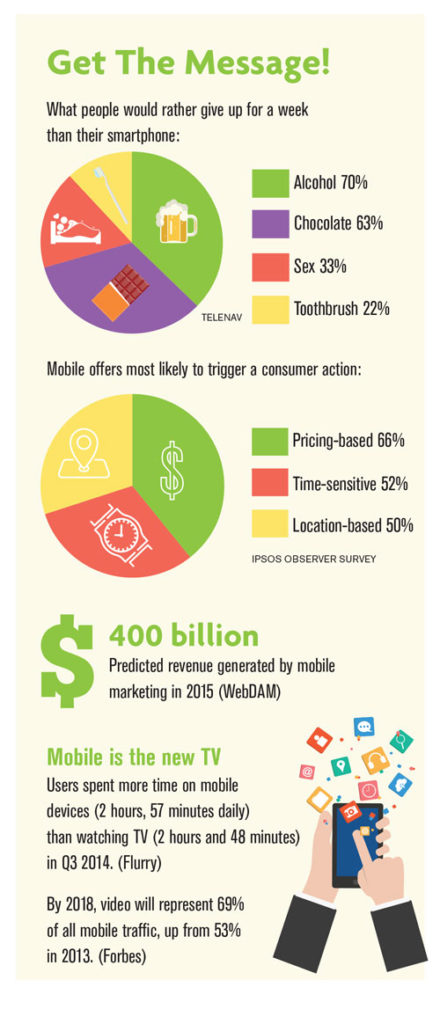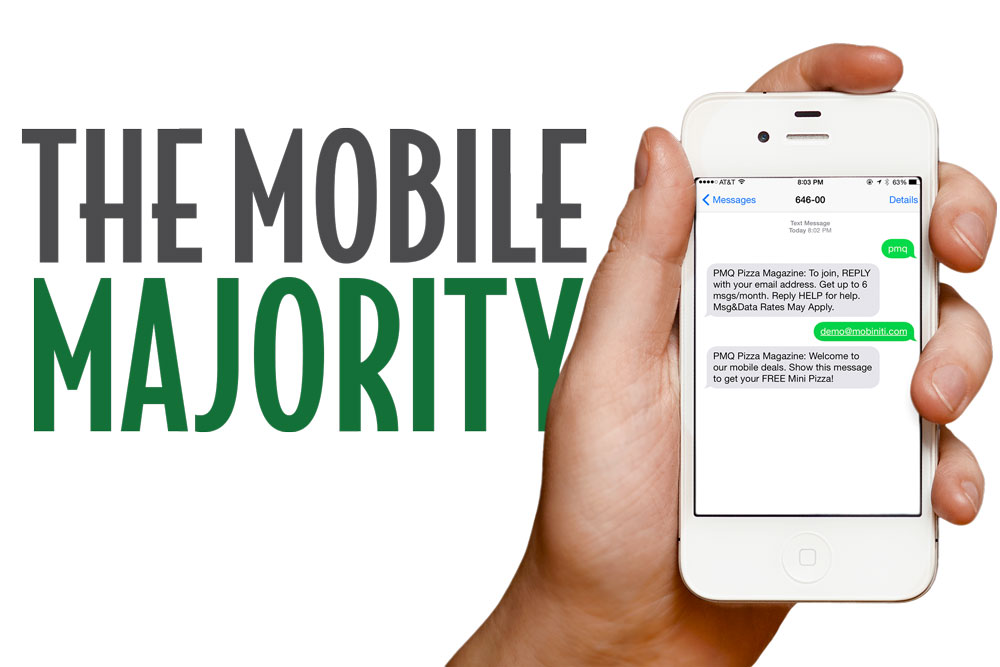Mobile marketing via text message has become a no-brainer for pizzerias large and small in recent years, and no wonder: In a world of instant gratification, operators have taken notice of studies that show 95% of text messages are read by consumers within four minutes of receipt.
And with nearly everyone nowadays toting cell phones, chances are, most of your customers have the ability to hop on your mobile marketing bandwagon.
It’s an astonishing opportunity for restaurateurs—text-based (or SMS) marketing is virtually guaranteed to get eyeballs. And because customers have to opt in to receive the messages, you know you’re targeting the right people with your message. “Leveraging mobile allows you to target customers within the vicinity of your restaurant instead of broader advertising that might reach those outside your immediate area,” notes Dan Bejmuk, CEO of Dreambox Creations in Los Angeles.
“Additionally, people using mobile devices are often looking for something particular—such as a pizzeria—and cell phones provide location awareness.”
Sounds straightforward enough, but there’s actually an art to text-based marketing, from attracting subscribers to sending messages that will ensure engagement and
redemption. Here, experts share how you can ensure success through cell phone-savvy marketing.
PMQ: Offer something of immediate value. The message should explain the benefits of acting NOW!
Building Momentum
When initiating a text-based mobile marketing program, pizzeria owners often opt for the simplest, quickest path with the fewest hurdles, and many companies offer Web-based mobile marketing software that an independent operator can get up and running in about 30 minutes, according to Jacob Weiss, client success manager at CallFire in Santa Monica, California. “Small businesses can sign up, purchase credits either on a plan or pay-as-you-go basis, upload a list of contacts, and start sending messages to their audiences,” he explains.
Chef Anthony Russo, Houston-based founder and CEO of Russo’s Restaurants, with 44 locations of Russo’s New York Pizzeria and Russo’s Coal-Fired Italian Kitchen (nypizzeria.com), agrees that those with fewer locations can keep it simple. Instead of going with a pricier custom-made app, smaller operators can use a third-party vendor, then streamline the program through their POS systems. “Building your database takes time, but once the traffic starts increasing, you’ll want to combine all of your databases, such as with your POS, online ordering customer info, or third-party plug-ins on your site,” Russo says. “Since we launched our new website in October 2014, we’ve had great success with a pop-up banner advertising our mobile program, which generates about 250 to 300 subscribers per week.”
Keep in mind you must obtain permission from customers to send them coupons and special offers via text message. “One approach we’ve seen work with great success is renting a keyword and printing posters, fliers and tabletop signs with calls to action, such as ‘Text SLICE [the pizzeria’s rented keyword] to 313131, and you’ll be enrolled in our VIP program,’” says Weiss. “Promote the keyword campaign on social media websites—the more often a customer sees a message, the more likely it will sink in—or you can place an iPad at the cash register with a simple online form for folks to type their phone number and check a box indicating they want to receive coupons via text message.”
 |
|
Consumers read 95% of their text messages within four minutes of receipt, studies show, making text marketing a can’t-miss strategy. |
Scoring the Sign-Up
Of course, bribery is also a great motivator to snag subscribers. Bejmuk points to a study done by his marketing partner, Fishbowl, that found incentives like freebies or discounts drive significant increases in sign-ups for mobile marketing lists. At Papa’s Pizza (papaspizza.net), based in Eugene, Oregon, with five locations, co-office manager Dori Kelty recalls being one of the first in the market to text specials to customers, back in 2008; the company attracted subscribers with $5 off a future order, while in-store banners and e-newsletters announced the program. Today, the company boasts more than 13,000 valid phone numbers on its list. “We started with really valuable offers for customers who signed up, such as ‘buy one, get one free’ deals, but now we’ve scaled back,” Kelty notes. “We now often promote our lunch buffet special, offer discounts, and promote new menu items, like our recently introduced flatbreads. Every time I check the numbers of subscribers, they’re up.”
Getting waitstaff on board helped boost interest at Sports Fans Pizza (sportsfanspizza.com) in Bettendorf, Iowa, according to manager Matt Trumbo. “The database took a while to build up, but many mobile companies’ sales reps can offer help by suggesting messages to send,” he says. “And even if a customer doesn’t redeem an offer, keeping in touch through text keeps your name front and center.”
Robert Speckert, owner of Pizza Tower (pizzatower.com), with two locations in Cincinnati and Covington, Kentucky, thinks of text coupons as another weapon in his technological arsenal, and he’s aggressive about spreading the word. “We put info about our text program on our website, pizza boxes, and the fliers that we hand out with every order. It’s even on our online ordering page when customers place an order and on our on-hold message system,” he says. “We offer a free dessert for subscribing, which really entices customers.”
PMQ: Don’t overdo it or they’ll opt out! Most studies show that 1 or 2 texts per week is about right.
On-the-Mark Messages
Before you begin texting with abandon, though, Bejmuk advises identifying your target customer according to daypart. Are you trying to reach the lunchtime, weekend or dinner crowd? Also nail down your brand message or story, then make sure every text communication reinforces it. “Some pizzerias are perennial discounters, so they’ll attract guests based on special offers,” Bejmuk says. “If you never discount, you must provide something else of value to the customer, something they’d read no matter who sent it, like a quirky bit of news or educational info that’s related to what your brand offers.”
The ultimate result: You’ll educate customers to become brand ambassadors, but with a soft-sell approach.
Weiss agrees pizzerias must offer something of value to their given demographic, but the concept of value will vary from market to market. “For example, a college-town pizzeria would benefit from sending hungry students offers such as two-for-one slices or a free medium pizza with the purchase of a pitcher of beer to drive foot traffic on nights when a local band is playing,” he explains. “It’s important to think of the offer as well as the time of day it’s sent; if it’s a meal offer, send it in the hours leading up to lunch or dinner. A family special may require a little more planning so parents can get the family on the road and in your pizzeria by 6 p.m.”
PMQ: Craving pizza tonight? Show this text to your server and get 20% off any large pizza! Good for tonight only!
In addition, text messaging is a great way to fill your pizzeria on slow nights, even at the last minute. Weiss notes some popular examples: “kids eat free” coupons, meal specials for late-night snackers, or a “buy one, get one free” offer on a slow Tuesday. Speckert, indeed, finds that “buy one, get one free” offers work best with his customer base.
Russo suggests featuring weekly specials, happy hours and new items in your text messages. Additionally, think about highlighting holiday specials or major events like the Super Bowl, Halloween and National Pizza Day. “But you can also have fun with the messages,” he adds. “For example, in addition to reaching out on a customer’s birthday, why not send a message on his half-birthday as a nice surprise? This builds a loyal following.”

Timing and Tracking
Russo also shares a tip to determine the ideal timing of your messages: Research your Web traffic through Google Analytics. “For us, the most traffic occurs 4 p.m. to 5 p.m., so we like to send our messages around 3 p.m.,” Russo says. His company sends info on weekly specials on Monday and Friday, while messages about special events are sent twice (four days before the event and one day before the event). “Based on our experience—and everyone is different—one or two messages per week has kept us happy,” Russo adds. “Ultimately, we’re able to gauge our impact by the number of users canceling their subscriptions. That’s when you know you should ease up!”
You should freely experiment to find your sweet spot when timing your text messages. Bejmuk notes that customer trends can differ for each brand, so there’s no “one size fits all” solution. “Just because you saw great response to a message sent at 3 p.m. on a Wednesday, don’t limit your messages to that time frame,” he advises. “You may find a surprising time of success—plus, we’ve found that content, both verbal and visual, is more important than timing.”
However, make sure you’re not an oversharer—sometimes there’s a fine line between delivering value and spamming your most loyal customers, notes Weiss. “Historically, we’ve observed that sending text messages to local pizzeria patrons before lunchtime, once or twice per week, has been a key driver of increased foot traffic,” he says. “Then, any opt-in list should be sliced and diced for maximum return. Keep track of customer preferences and send them a valuable offer that relates to those desires. On each offer, set a deadline; make it clear that he has a fixed window to redeem the offer.”
PMQ: Ask them to vote via text on their favorite pizzas or desserts. You’ll get valuable market research, and they’ll feel more connected to your pizzeria.
Tracking results for your mobile marketing program is a must. You can experiment in the beginning, but, eventually, you’ll want to get it down to a science. Tracking his program’s success has become second nature for Russo. He suggests sending a code with every message, so the customer can mention the code upon ordering and your employees can easily enter the code into the system, which is then logged and tracked in its online database. “They say redemption rates around 2.5% to 3% are good,” Russo says. “You should be able to monitor your redemption rates through a report via your app or POS. This allows you to view the number of downloads, messages sent, delivered, opened, clicked and unsubscribes. You can also view the customer’s contact information, location and, with some programs, frequency.”
For Russo, this type of reporting opened his eyes to a new level of targeting, enabling him to tailor specific messages to his fan base. In other words, mobile marketing isn’t just a tool to attract customers; it’s a way to keep them coming back, engage them with your brand, track their buying habits and better serve their needs. For savvy operators, connecting through text reaps a bevy of benefits. Are you ready to go mobile?















